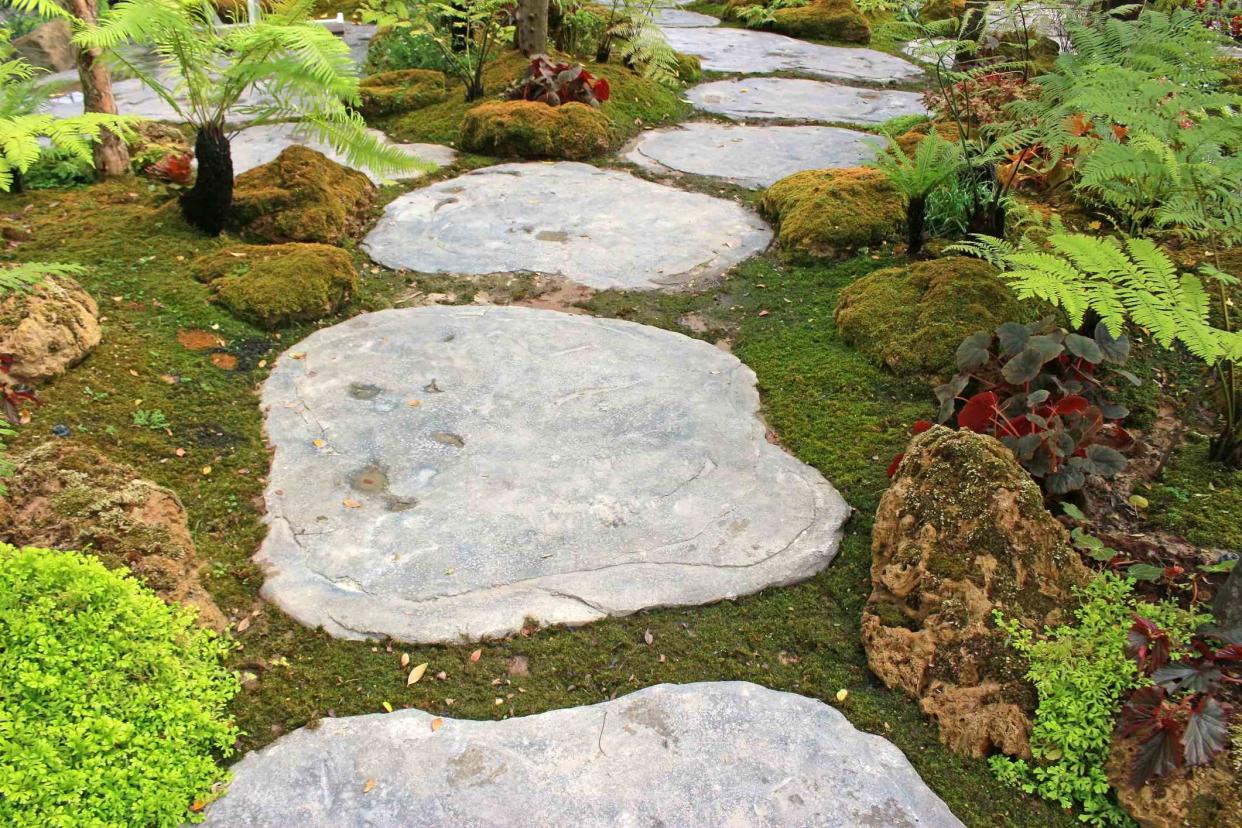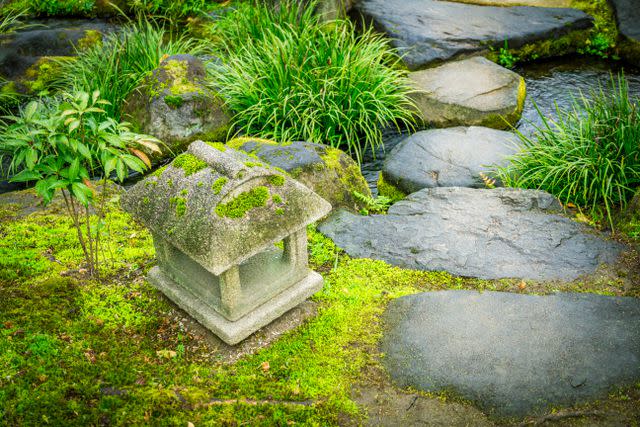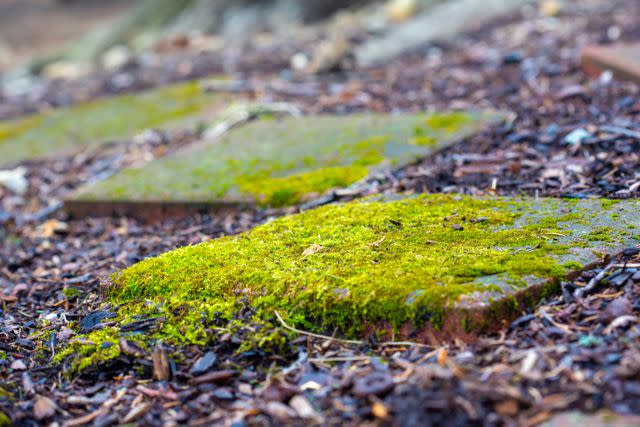A Guide to Growing Your Own Moss Garden Like a Pro

Hi-Point / Getty Images
For centuries, Japanese garden design has been integrating graceful, naturalistic, and minimalist moss into landscapes. But gardeners worldwide are now realizing that hardy, humble moss isn’t just a pesky plant you need to remove from roofs, lawns, and cracks in patios. Why not work with nature rather than against it and use moss to create environmentally friendly, verdant, and serene spaces?
Learn more about the benefits of cultivating this unappreciated and often overlooked greenery in your landscape and how to do it successfully with this guide to growing your own moss garden.
Consider the Best Spot for Moss to Flourish
Most moss varieties are great plants for shady gardens in damp, humid climates. Typically, prolonged exposure to intense sunlight will quickly turn spongy green moss frazzled and brown. However, always check the growing requirements of the moss species you have in mind.
Some can handle a wide range of conditions, from full sun to frosts. Loose, sandy soils aren’t ideal as they make it difficult for the moss, with its shallow rhizoids (root-like filaments), to take hold.
Unless you're growing a full moss lawn, you might want to start by covering a smaller rocky corner in your yard or creating a moss path with stepping stones. You can then extend upon this once you’ve established what moss grows best and how to care for it.
Types of Moss for Your Moss Garden
As many as 13,000 moss species are found worldwide, and more than 1,000 species grow naturally in the United States.
While not all of these species are suitable for moss garden cultivation, there are still lots to choose from. First, you need to decide if you want to go with acrocarpous or pleurocarpous moss varieties. Also keep in mind that native species tend to establish faster, are lower-maintenance, and better support biodiversity and local wildlife.
Acrocarpous Moss
Acrocarpous moss varieties grow slower and are more upright and mounding (although no mosses are tall plants) than pleurocarpous mosses. They are also drier and more delicate, so they aren’t the preferred choice as an alternative lawn ground cover.
The thick, tight form of these moss species keeps weeds at bay more successfully than pleurocarpous moss species. They are often drought-tolerant and don’t like to be constantly water-logged. Some acrocarpous moss varieties worth considering include:
Haircap moss (Polytrichum commune): This species, with wiry, spiked foliage, can tolerate more sun than some, especially when kept sufficiently moist. It’s ideal for humid regions with high rainfall.
Pincushion moss (Leucobryum glaucum): With longer and wider leaves than many mosses, this forms in dense clumping mounds. It prefers a partial or full shade position in moist soil.
Broom moss (Dicranum scoparium): This is a common and adaptable North American native, with dense, wispy, ‘swept’ leaves. It is ideal for growing on rocks and other hard surfaces, and it does well in partial sun to shade locations in dry to damp conditions. It propagates quickly, even if you only harvest a small amount.
Pleurocarpous Moss
Often known as carpet or sheet mosses, these creeping, flatter, faster-growing species can handle more foot traffic than acrocarpous varieties and prefer even moisture.
They attach readily to stone and are helpful plants for controlling erosion. Popular pleurocarpous moss varieties include:
American tree moss (Climacium americanum): This species, which uniquely resembles a miniature pine tree, appreciates moist soils and shady conditions.
Common fern moss (Thuidium delecatulum): A popular species for erosion control, growing on rocks and as an alternative lawn cover. It can handle partial sun and turns a golden shade in fall.
Feather moss (Hypnum imponens): Grows in dense, green mats, even in deep shade, and is ideal for growing in between pavers on walkways or on stone walls.

Fiona Crawford Watson / Getty Images
Sourcing Your Moss
Because moss isn’t an on-trend landscaping plant, it isn’t widely available in big box garden centers. Often you’ll have to order moss sheets or slurry from specialist sustainable suppliers, or, when legal and appropriate, you can harvest from local sites.
But that doesn’t mean you can remove large sheets of moss from nearby woodland. Check local restrictions, as collecting moss from national forests is often illegal without a special permit. It’s best to stick with collecting moss already growing on your property or that of friends, family or neighbors (with their permission).
Your neighbor might thank you for safely removing moss from their roof, but if they want to keep some of the characterful moss growing on rocks or as a ground cover in their yard, only harvest up to a third of what is there to allow the existing growth to regenerate.
Harvesting Moss
If your neighbor is allowing you to make off with some of their moss, you can employ various straightforward techniques to harvest it. It’s best to scoop up acrocarpous moss species. You can scoop, scrape, or rake up pleurocarpous mosses. Whatever method you use, always remove as much loose debris and weeds as possible before harvesting the moss.
Scooping: It’s easiest to harvest using this method after fresh rainfall, and it works well for removing moss on rocks or flat, hard surfaces like patios, roofs, or walls. Simply use a flat shovel or trowel to lift the moss off in strips. Ensure you lift a layer of soil to help protect the moss's hair-like rhizoids (root alternatives).
Raking: This works best for removing rootless moss when it is mixed in with rooted grass, weeds, or other plants. It’s most effective when the moss is dry, and lifting it with your fingers once the rake has started the process can be helpful.
Scraping: This is the trickiest technique to master, but it’s helpful if you don’t have any tools available. You can loosen the moss rhizoids from the soil using a push-and-pull action with the palms of your hands.
Encourage existing moss: If you find removing moss from your lawn tricky, why not embrace it? Keep mowing the grass low and retain consistent moisture. This helps the moss outcompete the grass.

Liyao Xie / Getty Images
Establishing Your Moss Garden
Once you’ve harvested or bought your sheets, it’s time to cultivate your moss garden. It’s best to do this in late spring or early fall when temperatures are mild and moisture levels are higher. Avoid summer planting when conditions are hot and dry. If you’re growing moss as a ground cover, whether that’s in a lawn or an ornamental garden area, follow these steps for successful establishment:
Many moss species prefer acidic to neutral pH levels. Test the soil. You might want to make amendments or select a new position if it is highly alkaline.
Get rid of debris, weeds, and other plant material to allow moss to thrive without competition.
Smooth the cleared soil to remove bumps and depressions.
Lightly rake and thoroughly dampen the soil, but don’t leave the surface too loose. Moss establishes better with a solid base.
Space large moss sheets a maximum of 1 foot apart. Smaller torn sections can be clustered around 1 inch apart. The patches will gradually fill in, resulting in a solid carpet.
Press the moss sheets into the soil by foot or hand, ensuring good contact. Air pockets can prevent the rhizoids from attaching successfully.
Pin down with chicken wire and rocks on the edges or walk on the sheets daily in bare feet or flat-soled shoes initially to encourage adherence.
Keep the soil evenly moist (not waterlogged) by misting during the establishment period. Depending on the species, you might have to water a few times daily for four to six weeks, tapering the watering schedule off over the next few months.
Be patient. It can take up to five months for some moss species to establish.
Establishing Moss on Rocks or Other Hard Surfaces
Attachment is slightly more tricky if you’re attaching the moss to stones, in between pavers, or on top of other hardscaping. If you pick a pleurocarpous moss species, it will usually regenerate more quickly and attach to the solid surface more effectively.
Shred your moss sheet into smaller pieces, dampen it, and press it against the stable surface. If it doesn’t adhere, try using a handful of pottery clay to help stick it to the surface, or briefly mix the shredded moss with water in a blender to create a spreadable slurry.
Warning
A widely circulated recommendation is to blend the moss with acidic yogurt, buttermilk, or beer to create an adhesive moss paste or slurry. Experts caution against this as it can encourage mold.

Katkami / Getty Images
Caring for your Moss Garden
Care requirements vary depending on the species you select and local conditions, but the following tips can help you keep your moss garden looking green.
Remove debris: Keep moss free of leaf litter and other debris using a leaf blower, gentle rake, or bamboo broom.
Weeding: Weeds can quickly kill off moss, so regularly remove any aggressive competitors.
Watering: Many moss species are surprisingly drought-tolerant and don’t appreciate being waterlogged. You might not need to water a moss lawn or garden all that often, if at all, once established.
Footfall: Mosses don't tolerate heavy footfall, but some can handle light traffic once established. Others may benefit from being planted around stepping stones or pavers.
Benefits of Moss Gardens
You might be unable to nurture a blanket of beautiful moss in the sunniest and most arid conditions, and it isn’t ideal for high-footfall areas. However, growing a moss garden has lots of appealing advantages.
Aesthetics: A green, damp, moss-covered landscape has a timeless, serene, and magical quality. The Japanese use moss as part of the wabi-sabi aesthetic, which centers on accepting transience and imperfection. It embraces rough, asymmetrical, simple, and intimate design principles.
Many design applications: Moss can be used as an alternative lawn cover to add interest in a rock garden or create a magical mood in a fairy garden. You can also grow moss between pavers or walls in a cottage garden.
Stress-relieving: Walking barefoot in spongy, tactile moss can create a restful, spiritual, anxiety-reducing atmosphere.
Attracts wildlife: Mosses can be home to beneficial fungi, insects, frogs, and salamanders. Birds and squirrels harvest moss for their nests and dreys. Handily, though, most mosses are deer-resistant ground covers.
Drought tolerance: Many moss species are drought-tolerant once established. This is especially useful when growing over large spaces. Moss needs much less water than a grass lawn, making it a convenient and water-conserving option.
No mowing or pruning: Low and slow-growing moss doesn't need mowing like grass or pruning like some other ground covers.
No fertilizing: Because rootless moss gathers nutrients and moisture through its surface from the air, you won't need to fertilize a moss garden.
Erosion control: Moss doesn't require soil to grow, and the hair-like rhizoids anchor themselves to most bare surfaces, making them great for supporting erosion control.
Grows where other plants won’t: Unlike many landscape plants, moss can grow in deep shade and poor-quality, compact, acidic soil. Moss also attaches readily to rocky ground and solid substrates like stones and logs. If you're struggling to nurture green spaces in your garden conditions, moss could be the way to go.
Reduces air pollution: Moss is highly effective at filtering out air pollution and is a bioindicator that allows more effective monitoring of atmospheric pollutants..They are impressive carbon captures, which can help in the fight against climate change.
Read the original article on The Spruce.

